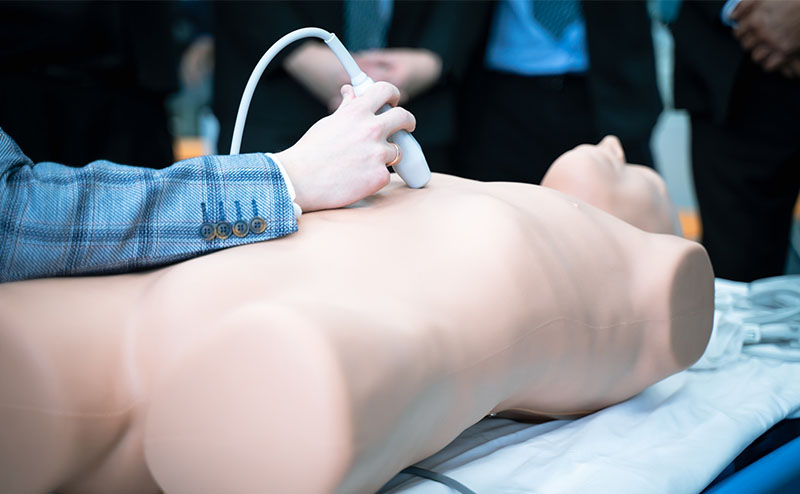
"Hot Seat" – with John Kendall for the US component of ABEM Certifying Exam
Interview completed by
Megan Hilbert, MD
ACEP EUS Newsletter Editor
Questions and content edited by
Laura Oh, MD, FACEP
ACEP EUS Secretary
For this hot seat we are talking with Dr. John Kendall regarding changes to the ABEM certifying exam and its impact on testing of ultrasound skills. For those who do not know, Dr. Kendall is a member of the ABEM Board of Directors. He has also served as an EUS director, EUS Fellowship director, and systemwide ultrasound co-director for multiple health systems on the West Coast. His contributions to the field of emergency ultrasound are exemplary. In 2016 ACEP recognized him with a lifetime service award for his contributions to the US section. There is no one better to talk to about this so let’s get started.
A quick background regarding the changes to the certifying exam. Per ABEM’s website, the goal of these changes is to “test additional competencies that cannot be tested on the Qualifying Exam or current Oral Exam.” The exam is completed in person in Raleigh, NC and is composed of clinical care cases and communication and procedural cases. Ultrasound is listed as a content area in the communication and procedural cases description. Candidates will be asked to acquire and interpret ultrasound images on a standardized patient actor. Candidates will be graded on proficiency in obtaining ultrasound images, accurate interpretation of images, as well as providing patient-centered care.
To review the exam further please visit ABEM’s website: ABEM | Certifying Exam
Jumping into questions.
Q: Dr. Kendall, thank you so much for taking the time to engage in our hot seat discussion and answer our questions. Many are likely questioning why we have moved from the traditional oral board exam to the new certifying exam; could you please comment on what ABEM hopes to achieve with these changes?
A: All you really have to do is look no further than ultrasound. It is an extremely important part of the practice of emergency medicine, yet it wasn’t evaluated in any meaningful way. Ultimately, the new Certifying Exam is the outcome of a multi-year investigation and development where ABEM engaged the emergency medicine community. There were more than 4,300 different inputs that contributed to this process and agreed with the need to develop a new exam. We needed to assess more than just medical knowledge and yet medical knowledge is still important. So the written exam is still going to be part of what will be included moving forward. It was agreed upon, however, that the new exam needed to address additional competencies that are important in the practice of emergency medicine; things like ultrasound and procedural skills. Those things just couldn’t be assessed meaningfully in the current iteration of the oral exam.
In addition to new content, it was consistent across the board that we needed to maintain high standards and be able to adapt, much as emergency medicine practice has changed over the years. Not only that, but they also wanted us to develop a meaningful assessment experience. So, when a candidate takes this assessment they think, “that is what my practice is”. That is ultimately what we hoped to try to do with the exam.
Q: The certifying exam will include a hands-on ultrasound component. Given the breadth of core applications in emergency ultrasound (ACEP US Guidelines list 15), do you see the ABEM exam as having the ability to demonstrate competency in point-of-care ultrasound in totality even though it will only test a few applications?
A: The first thing I would say is that the exam is going to be based on the Emergency Medicine Model of Clinical Practice [aka: Core Content; section 19.5 Ultrasound; found here: 2022 Model of the Clinical Practice of Emergency Medicine]. While there are similarities between the ACEP ultrasound guidelines and the EM model of clinical practice, ultimately the Core Content should be considered the source document for the new Certifying Exam. I think it is important to keep in mind that really none of ABEM’s assessments are constructed to cover the entire scope of practice. The Qualifying Exam, Oral Exam, and new Certifying Exam are designed to provide enough information to make a summative decision to support certification decisions. The hope is that the Certifying Exam assesses a sufficient sample of the Core Content to be psychometrically valid and reliable.
Q: Are all 15 core applications considered fair game or are there certain applications that aren’t considered testable at the moment that will be fair game in the future?
A: The current iteration of the ultrasound case type will include at least two image acquisition and two interpretation components. We have been very purposeful in selecting different areas of acquisition and interpretation so we will be able to assess ultrasound applications more broadly. For example, if one case involves a cardiac application, the second case would be something distinctly different. That is purposeful because we want to make sure that no candidates have an advantage or disadvantage depending upon the focus of their residency program’s ultrasound curriculum. It is important to note that the ultrasound acquisition application (ie: cardiac) would have a concurrent interpretation of a cardiac exam. The format of the exam gives flexibility to assess interpretation of an ultrasound clip for a wide range of pathologies.
All of the applications listed in the EM Model should be considered eligible for assessment in the Certifying Exam, however, the physician may be asked to interpret images only, rather than perform the scan for several applications listed. That includes transvaginal ultrasound, testicular ultrasound, or evaluation of bowel obstruction. We would encourage program directors to review the EM Model as it will become more apparent that the scans listed are relevant and likely have already been included in the majority of residency program ultrasound education.
Q: How do you see the ultrasound component of the board exam evolving over time?
A: During mock-testing of the new exam, test candidates have been able to complete all of the required tasks in the 10-minute time period. I can envision a time where candidates become more comfortable with the interface and case type and are subsequently asked to complete another [or third] image acquisition and interpretation. This would be similar to some other specialty boards who also assess ultrasound competency as a part of their certification process.
Q: For physicians who are taking the certifying exam in 2026, is there anything in particular you would recommend to help them prepare?
A: Such a good question. Ultimately the exam assesses what emergency physicians should be capable of doing before they embark on a career of independent practice while meeting the standards of the specialty. Residents have been preparing for this new exam since starting residency.
One aspect of the exam that may be unique for some candidates is talking through what they are seeing during the image acquisition and interpretation components of the assessment. For example, the candidates will want to be able to verbalize structures that are present in the images they acquire. When shown an ultrasound clip to interpret, they will use a mouse cursor to point out significant anatomy, artifacts, or other findings and describe how they would interpret the video. The candidates will also be responsible for directing the examiner in adjustment of the ultrasound machine itself. They will need to be able to direct the examiner in probe and preset selection, depth and gain adjustments, or adjustments of other settings to optimize the image.
It is also important to note that the ultrasound case type will also be assessing how candidates interact with the standardized patient actors. The goal is to set up a situation that is as realistic as possible to an actual patient encounter. As such, the candidates will be expected to interact with the actors like they would a real patient and the actors will respond accordingly. Candidates will not, however, have to obtain any history or perform a physical exam on the standardized patient actors. Any clinical information that is relevant to the case will be provided on the initial data sheet or by the examiner. Again, the goal is to focus on ultrasound acquisition and interpretation skills and how candidates interact with the standardized patient actors.
There are a lot of resources that are available on the ABEM website including a sample ultrasound case and summary. Looking through that would be a good way for candidates to see what the interface is like, how they will interact with the examiner, and what the standardized patient actors will be like.
Q: Do you have any final thoughts that you would like the ultrasound community to be aware of regarding this exam?
A: Yes. I think first, this is like what we do in clinical practice. That should be, I hope, comforting to candidates. Those things they are doing in clinical practice will be what they are going to do here [on the exam]. If you are doing a wide range of things within the scope of your practice, then this should be something that is very familiar to you. The other thing, from an ultrasound community perspective, is that it is pretty amazing that ultrasound is one of the things that is now a part of the certification process. When thinking back over the years and the maturation of ultrasound within our specialty, it really gives a sense of pride that ultrasound is now included. It shows how we as a specialty embrace and recognize the importance of ultrasound.
Dr. Kendall, we thank you so much for your time and insights. We are looking forward to seeing how this new exam unfolds and supports how integral ultrasound is to the practice of emergency medicine.



